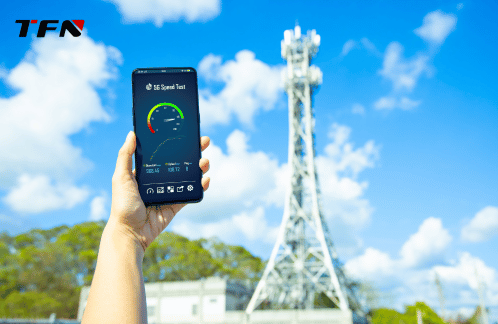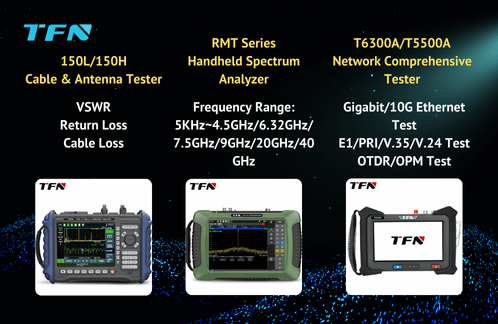How to use communication test instruments to quickly detect the operation of 5G base stations
As a new generation of mobile communication standards, 5G technology is gradually being applied to all walks of life and thousands of households. 5G networks require higher data speeds, lower latency and higher reliability, which requires large-scale upgrades and transformations of network infrastructure. As a new generation of communication infrastructure, 5G base stations are the key to supporting 5G network speeds and are also the focus of infrastructure construction in various countries. 5G base stations have these main characteristics:

Dense deployment
5G networks require a large number of small base stations to provide higher capacity and coverage. These small base stations can be installed in various scenarios such as streets and buildings.
Multi-band support
5G base stations can support both low-band (sub-6GHz) and high-band (millimeter wave) spectrum, and flexibly adapt to different coverage and capacity requirements.
Massive antenna array
5G base stations use massive MIMO antenna technology to serve multiple users at the same time and improve spectrum utilization efficiency.
Ultra-low latency
5G base stations can achieve end-to-end latency as low as 1 millisecond through optimized air interface protocols and network architecture, meeting applications with high real-time requirements.
In addition to these features, 5G base stations also have dynamic beamforming capabilities, which can improve coverage and capacity by adjusting antenna beams; support network slicing technology, which can customize networks for different services; support virtualization and cloud deployment to improve flexibility and scalability; use advanced power amplifiers and cooling technologies to greatly improve energy efficiency; have stronger automation and intelligence capabilities, and can achieve automatic configuration.

As more and more 5G base stations are built and put into use, the testing tasks and difficulty of 5G networks and base stations are gradually increasing. Using professional 5G test communication test instruments can effectively judge the performance and health of base stations. The following are some commonly used tools and steps:
1. Spectrum analysis and interference detection
Testing instruments:
Spectrum analyzer: used to detect the spectrum distribution of wireless signals and check whether there are interference and signal quality problems.
Steps:
1.1 Turn on the spectrum analyzer and select the appropriate frequency band.
1.2 Scan the working frequency band of the base station to detect signal strength and signal quality.
1.3 Check whether there is adjacent channel interference or other forms of signal interference.
Purpose: Confirm whether the transmission spectrum of the base station meets the specifications and whether it is interfered by the outside world.
2. Signal strength and coverage detection
Testing instruments:
Signal strength meter: measures the electric field strength and signal strength to evaluate the coverage effect of the base station.
Steps:
2.1 Use a signal strength meter to measure the signal strength at different locations around the base station.
2.2 Record the signal strength value, draw a coverage map, and check whether the coverage meets the design requirements.
Purpose: Evaluate whether the signal coverage and strength of the base station meet the requirements.
3. Network performance test
Testing instruments:
Network tester: used to perform various network performance tests, including throughput test, delay test and packet loss rate test.
Steps:
3.1 Use the network tester to connect to the base station and perform throughput test, delay test and packet loss rate test.
3.2 Test the network performance of uplink and downlink, record the test results, and compare with the operator's SLA (service level agreement).
Purpose: Determine the overall network performance of the base station, including bandwidth, delay and stability.
4. Antenna and feeder system test
Testing instruments:
Antenna-feeder tester: Find problems with the antenna and feeder system, such as VSWR (voltage standing wave ratio) and feeder return loss.
Steps:
4.1 Use the antenna and feeder tester to test the VSWR of the antenna and the feeder return loss.
4.2 Check whether there are problems with the antenna, feeder and connector, such as excessive reflection loss or abnormal feeder loss.
Purpose: Ensure that the antenna system and feeder are working properly and reduce signal reflection and loss.
5. Mobile terminal test
Testing instruments:
Mobile terminal analyzer: used to simulate user equipment, test connection performance and data transmission rate.
Steps:
5.1 Use the mobile terminal analyzer to simulate the user equipment connected to the base station.
5.2 Test the connection stability, data rate and service quality.
Purpose: Simulate the actual user usage scenario and test the user experience of the base station.
Through these steps and tools, the operation of 5G base stations can be quickly, effectively and accurately tested to ensure that their performance meets the standards and potential problems are discovered and resolved in a timely manner, thus improving the efficiency of the testing team. TFN provides different types of professional testing instruments for 5G base station testing, which can easily achieve the above test functions and effects:

Product name |
Model |
Core parameters |
Main functions |
Spectrum analyzer |
RMT716A |
Frequency range: 5KHz~6GHz |
Spectrum analysis + interference analysis + base station analysis + road test coverage + signal analysis |
Antenna-feeder tester |
150H |
Frequency range: 2MHz~6GHz |
Antenna feeder test (VSWR+return loss+cable loss) |
Network tester |
T6300A |
10/100/1000M Ethernet |
Ethernet test + E1 test + PRI test + RFC2544 (throughput, delay, packet loss rate) + OTDR + optical power meter |
T5500A |
10G Ethernet |
||
Wireless signal analyzer |
FMT760C |
Maximum frequency: 6GHz |
Spectrum analysis + interference analysis + base station analysis + signal analysis + antenna feeder test |
WIFI terminal inspection equipment |
CWF1 |
Support WIFI3/4/5/6 |
Terminal equipment wireless signal analysis + equipment interference location + target signal demodulation analysis |
If you are interested in TFN's test equipment for 5G base station testing, please contact TFN sales team:
Email: info@tfngj.com
WhatsApp: +86-18765219251
Facebook: https://www.facebook.com/tfnfate/
